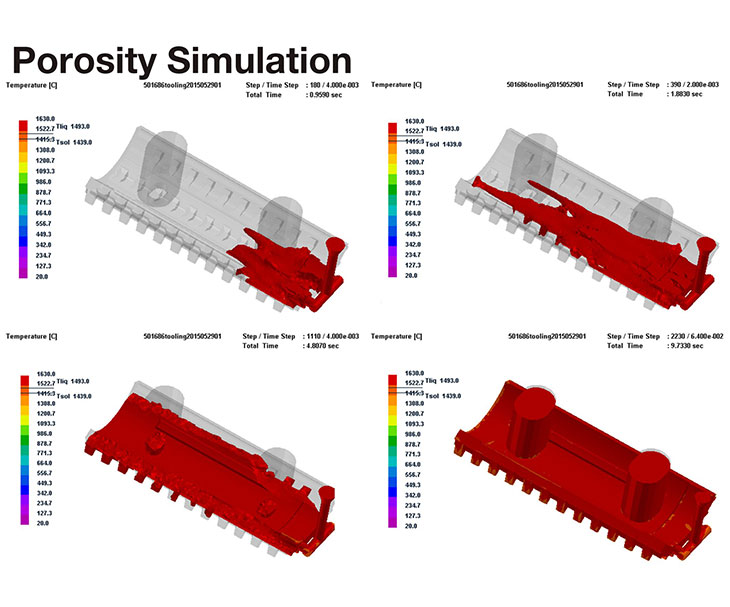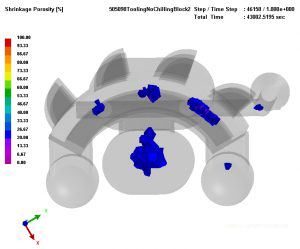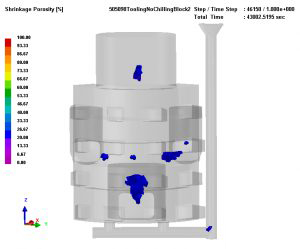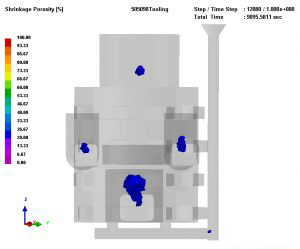We are always ready to help with your latest Casting project.
Contact our Customer Service and let us know how we can help to catapult your next project to success.
Porosity refers to a hole or void in an otherwise solid cast metal part. The size of pores can range from microscopic (micropores) to larger voids, measured in cubic millimetres or more. A porous is not always circular in cross-section, but can also occur in the form of irregular linear cracks.
There are two major causes of porosity: solidification shrinkage and gas porosity. In the following sections, we will explore the root causes of these two types of violence and suggest strategies to fight them.
Mold cavities solidify when the molten metal comes into contact with relatively cooler walls. As the metal solidifies, it shrinks; however, the rate of shrinkage will vary depending on the geometry of the mold tool and the type of alloy.
In this semi-liquid metal, pore formation is more likely to occur further away from the tool wall, which is called slush. The solidified metal might also block the flow of liquids to other areas in the mold once it becomes solidified. It is possible to create pores when preventing full liquefaction of all design features.
A gas pocket can form in a few different ways. With aluminum, hydrogen may fall out of suspension and fill voids with hydrogen gas.
It is possible that the mold tool may have been partially or completely vacated or vented as the cavity filled. Air that is trapped in this manner is called entrained air.
In addition to the liquids mixed with the molten metal, other liquids may be injected along with it. Among these might be mold release agents, hydraulic fluid leaks or even humidity. It is possible to vaporize and create gas bubbles from any of these substances. A liquid or oil that does not evaporate can become a contaminant which can lead to particle inclusions in the final product.

ProCAST is an outstanding finite element solution for simulation of metal casting processes. Designing and developing processes with this tool will help improve yields and casting quality.
With comprehensive finite element solvers, accurate and efficient output, ProCAST meets the manufacturing industry’s needs. By reducing manufacturing costs, improving mold development time and improving casting quality, the software is the ideal alternative to traditional trial-and-error methods.

In addition to predicting residual stress, ProCAST is an expert at predicting deformations and it can also be used for more specific processes, such as sand casting, investment casting, die casting, lost foam casting, etc.
Simulations help foundries analyse how metals expand and contract in the process of casting, so they can predict where shrinkage porosity will be located. There are several possible defects that can occur during a casting process, causing a final product to be imperfect. Therefore, an effective gating and feeding system is essential for reducing or eliminating these defects.
By seeing how castings fill and solidify within a mold, manufacturers can validate and improve the locations and sizes of the down sprue, runners, gates, vents, chills, and feeders. ProCAST is used as a tool to simulate casting processes and ensure that molds are made correctly the first time.
With Omnidex ProCAST Software, our customers will not recevie any scrap cast parts in the future. ProCAST has served as their go-to tool to predict porosity, filling, and solidification of castings for decades. It can also predict complex issues like deformations and residual stresses, and it is capable of dealing with most castable alloys, most casting processes such as sand castings, die castings, investment castings, and the variants that go with each process.




There are no 100% perfect casting processes. Porosity in metals must be considered despite excellent properties.
It is almost always sand casting that is the most favorite and popular foundry process. The ability of sand casting to casting large volumes, high-quality and low-cost make it an exceptional machining process. Yet, examination of sand casting defects is vital to determining the customer’s tolerance as well as expectations.
We at Omnidex are transparent about casting defects that can occur during the process with our customers. We always strive to minimize the number and severity of casting defects so that we can supply the best quality products.
Furthermore, we monitor the gates and pouring process continuously in order to ensure that they are working properly in accordance with each casting requirement. In this way, we can ensure our customers receive the best quality of metal casting services and products.
The Omnidex Casting team is committed to providing quality machining and manufacturing services with no compromise. If you are interested in our metal casting services, feel free to contact us for a quick quote.
Contact our Customer Service and let us know how we can help to catapult your next project to success.
This website uses cookies so that we can provide you with the best user experience possible. Cookie information is stored in your browser and performs functions such as recognising you when you return to our website and helping our team to understand which sections of the website you find most interesting and useful.
Strictly Necessary Cookie should be enabled at all times so that we can save your preferences for cookie settings.
If you disable this cookie, we will not be able to save your preferences. This means that every time you visit this website you will need to enable or disable cookies again.